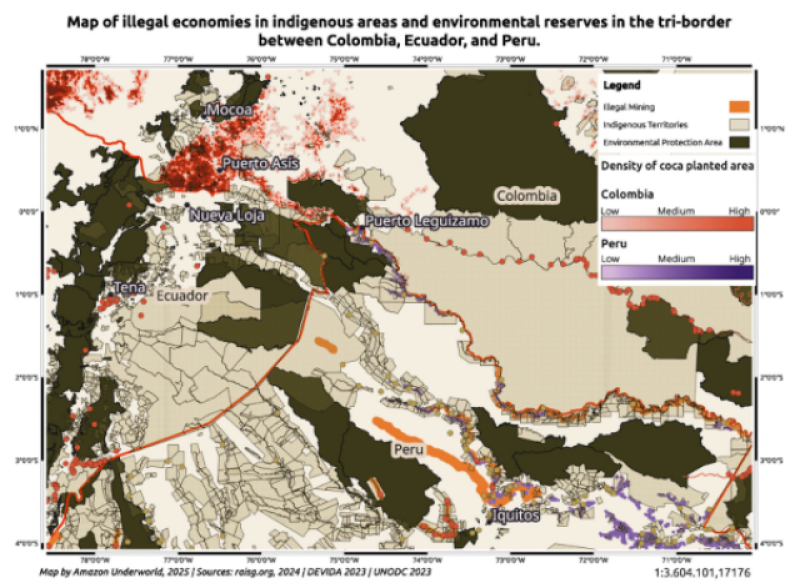- Why inclusion matters for tackling corruption |
- JS polls to be held by February 15: Shafiqul Alam |
- Myanmar Faces War, Disasters, Hunger, and Mass Displacement |
- UN Warns Israeli Doha Strike Risks Regional Escalation |
- Nepal protesters' families seek justice amid confusion |
Illicit Economies, Armed Control along Colombian-Ecuador-Peruvian Amazon border

Map of Amazon underworld 2025
Bogota, Colombia – A new report by Amazon Underworld and Amazon Watch reveals the mechanisms of control used by criminal networks, the capture of territories, and the structural absence of effective state governance in the tri-border area between Colombia, Ecuador, and Peru. It provides a detailed account of the control exercised over daily life, commerce, and the everyday activities of local communities, as well as the forced recruitment of minors – turning the tri-border into one of the most violent regions in Latin America. In recent years, the tri-border area has seen the assassination of social leaders, multiple massacres in communities, forced displacement, and even attacks on the armed forces.
The investigation – the result of eight field visits conducted between November 2024 and July 2025 – is based on more than 70 confidential interviews with key actors, including Indigenous leaders, representatives of social organizations, ex-combatants, members of armed groups, public officials, journalists, prosecutors, environmental defenders, and international officials. The findings confirm what many communities already knew: armed groups are not only competing for routes, but also governing territories, leading to massive environmental destruction in the heart of the Amazon.
Bram Ebus, founder of Amazon Underworld:
“The tri-border has become a hub for organized crime and drug trafficking, but for this very reason, it could also become a laboratory for peacebuilding and drug policy. Only if the governments of Colombia, Ecuador, and Peru replicate what organized crime has long mastered — cross-border cooperation – will it be possible to reverse the dynamics of violence and environmental destruction.”
Raphael Hoetmer, Director of the Western Amazon Program at Amazon Watch:
“We stand at a tipping point. Without a decisive shift toward a security strategy rooted in cross-border cooperation, community leadership, and tackling the structural causes of violence, criminal governance in the tri-border will deepen and spread into Ecuador and Peru. Peace and security in the Amazon are impossible without Indigenous peoples at the heart of the solution. This week in Bogotá, Amazonian nations have a historic chance to change course – and it may not come again.”
Main findings of the report
An Unprecedented Armed Presence in the Amazon Basin
Groups such as the Comandos de la Frontera (CDF), FARC dissidents, Los Choneros, and Los Lobos exercise effective control over entire rural areas, surpassing state forces in influence and presence. In regions such as Putumayo, Napo, Sucumbíos, and Loreto, these structures operate with impunity, collect “taxes,” monitor movement, and regulate everyday activities.
From Criminality to Parallel Governance
Beyond sporadic violence, armed actors have consolidated systems of social and political control: they impose curfews, infiltrate community structures, compel attendance at weekly meetings, and replace traditional authorities. In many cases, criminal governance is the only order available to abandoned communities.
Environmental Collapse in Areas Critical to Global Climate Stability
Illegal mining activities have devastated protected natural reserves, with high levels of mercury contamination documented in water, fish, and human populations. River borders no longer represent state limits but have become logistical corridors for chemical supplies, drug trafficking, gold smuggling, weapons, and fuel.
Failure of Militarization and Institutional Collapse
State responses have oscillated between neglect and militarization. Rather than reducing violence, armed operations have led to new massacres, displacement, and human rights violations, while corruption undermines any possibility of sustainable territorial recovery. In Ecuador, Colombia, and Peru, cases of collusion between law enforcement and criminal structures are documented.
The Threat of Escalation and the Opportunity for Peace and Structural Cooperation
Despite the complexity of the situation, the report identifies concrete opportunities: peace talks with the CDF in Colombia, existing multilateral platforms such as OTCA and the Andean Community, and community demands for viable economic alternatives offer a foundation for a coordinated regional response.
Core recommendations
• Launch a regional security strategy with territorial and environmental focus, led by OTCA, with direct participation of Amazonian communities, Indigenous leaders, and grassroots organizations.
• Strengthen protection mechanisms for environmental defenders, promoting Indigenous justice systems and recognition of territorial guards.
• Advance gradual substitution of illicit crops, with real public investment, land titling, and access to alternative markets.
• Incorporate urgent ecological restoration actions and cleanup of contaminated rivers, in coordination with environmental prosecutors and multilateral organizations.
• Strengthen peace negotiations with human rights guarantees and international verification, involving Ecuador and Peru.
A call to action before the presidential summit
The report will be officially presented as part of the preparatory events for the 5th Presidential Summit of the States Parties to the Amazon Cooperation Treaty Organization (OTCA). The event will be attended by diplomatic representatives, international organizations, civil society, researchers, and territorial defenders.
The Amazon cannot continue to be governed by armed networks while states retreat. The response must be as transnational as the problem. Real regional cooperation is needed, centered on respect for human rights, environmental sustainability, and the self-determination of the peoples who inhabit the rainforest. – Amazon Watch

